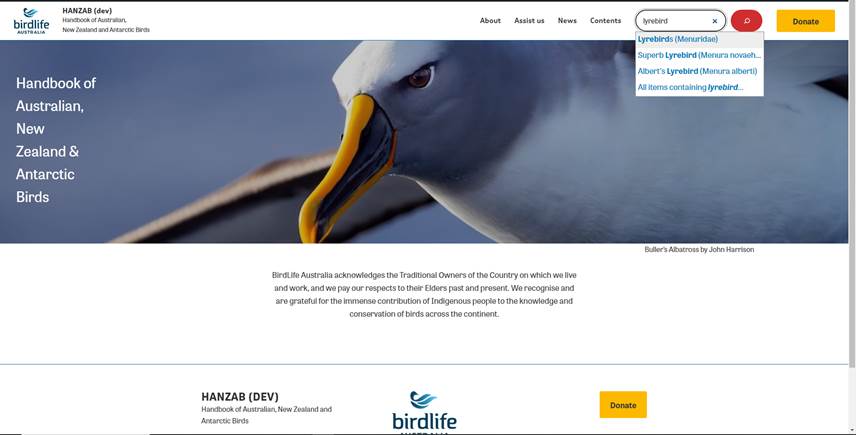I have been asked for an update on progress with HANZAB online.
About 12 months ago, I gave a talk at a COG meeting about the upcoming release of HANZAB online. For various reasons, it has not been possible to do the release, but rest assured that work has been progressing. However,
I am still not able to provide a release date.
Some of the main changes since my talk are:
- The Home page has changed (see screenshot below) and the HANZAB book grouping of information by volume has been removed.
- Search has been implemented (see top right of screenshot below) – see below for more information.
- The taxonomy has been updated using Working List of Australian Birds 4.1 (Birdlife Australia),
Checklist of the Birds of New Zealand, Fifth Edition, 2022 (Ornithological Society of New Zealand) and Handbook of the Birds of the World and BirdLife International digital checklist of the birds of the world.
Version 7. See below for more information.
- Entries for orders now include a list of families in the order, families include a list of subfamilies or a list of species if no subfamilies
in the family and subfamilies include a list of species in the subfamily. For example, the following list of families is included in the entry for Pelecaniformes order (note the significant taxonomic change to this order with Families
Ardeidae and
Threskiornithidae moved from
Ciconiiformes)(in HANZAB, the text in blue is a link to the entry in HANZAB – link has been removed here)
Families (7)
·
Ibises and spoonbills (Threskiornithidae)
·
Herons, Egrets and Bitterns (Ardeidae)
·
Pelicans (Pelecanidae)
·
Frigatebirds (Fregatidae)
·
Gannets and boobies (Sulidae)
·
Cormorants and shags (Phalacrocoracidae)
·
Darters (Anhingidae)
-
Species, subfamily and family entries have links to the next and previous entry in the taxonomy at the same level as well as links to the higher levels. Order entries only have links to next/previous order. For example
the Blue-faced Honeyeater has the following links in the header.
PASSERIFORMES › Meliphagidae
◄ Brown
Honeyeater |
White-quilled Honeyeater ►
Some more information about search and taxonomic changes.
The search is accessible from all entries and works at both the title (common name and scientific name for species, or title for other pages ) and content level. In the attached screen shot, the search for ‘lyrebird’
lists the three entries with lyrebird in the title [Lyrebirds (Menuridae), Superb Lyrebird, Albert’s Lyrebird] as well a link to a list of all entries with the items with ‘lyrebird’ in the text (27 entries in this list). Searching for the lyrebird genus ‘Menura’
returns a similar list. The whole of the contents of the site is indexed. This allows, for example, searches for entries using a particular reference or those mentioning particular food items. For example, a search for ‘Sonneratiaceae’
(a plant family) returns a list of seven species (Red-headed Honeyeater, Rufous-banded Honeyeater, Brown Honeyeater, White-gaped Honeyeater, Varied Honeyeater, Blue-face Honeyeater and Little Friarbird).
The taxonomic changes are reflected in the masthead information for each entry (ie. common name, scientific name, prototype, subspecies reflect the current taxonomies) but have not been applied to the text for
the majority of species yet. As an example, Blue-faced Honeyeater the information below (list of subspecies and Taxonomic Changes) is an extract from the masthead. Note that because of the taxonomic change, the subspecies list now does not include
albipennis.
Polytypic Nominate cyanotis,
from base of C. York Pen. S through Qld E of Thomson–Barcoo Drainage Basin to ne. coast of NSW, SW through Murray–Darling Basin to n.-central w. Vic. and se. SA; griseigularis van Oort, 1909, Fly–Digoel
region, s. New Guinea, and C. York Pen.
Taxonomic changes since HANZAB book published
(Change may have happened before any checklist referenced below)
Blue-faced Honeyeater Entomyzon cyanotis in HANZAB book (see Original Text below) split:
·
subspecies albipennis elevated to White-quilled Honeyeater Entomyzon
albipennis
·
remaining subspecies remain as Blue-faced Honeyeater Entomyzon cyanotis.
Text does not reflect this change.
Although the species has been split, the text for Blue-faced Honeyeater below the masthead has not been altered to reflect this change yet. Also a new entry for White-quilled Honeyeater has been included but is awaiting
text. Until the text is revised/added, readers should use the taxonomic change information to determine which species the information applies to. In the Blue-faced Honeyeater example, any reference to subspecies
albipennis or locations within the range of
albipennis should be read as information about White-quilled Honeyeater. An annotated index, which includes all species common names from the HANZAB books and all current
common names, summarizes all the taxonomic changes, can also be used to determine entries which have changed.
There is a lot of work still to be done but I hope the website, when released, will be a useful resource.
I am happy to answer any questions.
Steve
Screenshot of HANZAB home page.


